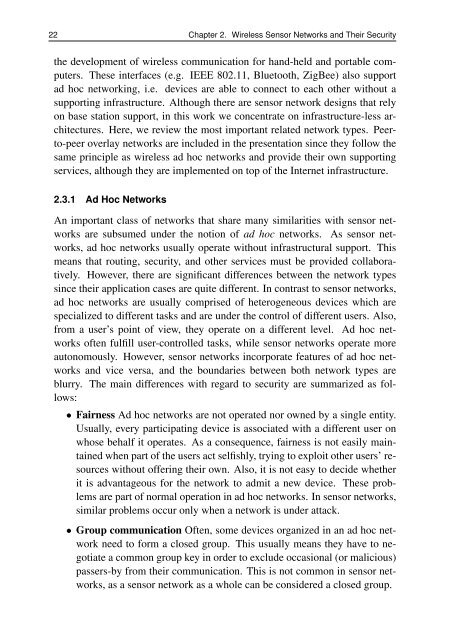Protocols for Secure Communication in Wireless Sensor Networks
Protocols for Secure Communication in Wireless Sensor Networks
Protocols for Secure Communication in Wireless Sensor Networks
Create successful ePaper yourself
Turn your PDF publications into a flip-book with our unique Google optimized e-Paper software.
22 Chapter 2. <strong>Wireless</strong> <strong>Sensor</strong> <strong>Networks</strong> and Their Security<br />
the development of wireless communication <strong>for</strong> hand-held and portable computers.<br />
These <strong>in</strong>terfaces (e.g. IEEE 802.11, Bluetooth, ZigBee) also support<br />
ad hoc network<strong>in</strong>g, i.e. devices are able to connect to each other without a<br />
support<strong>in</strong>g <strong>in</strong>frastructure. Although there are sensor network designs that rely<br />
on base station support, <strong>in</strong> this work we concentrate on <strong>in</strong>frastructure-less architectures.<br />
Here, we review the most important related network types. Peerto-peer<br />
overlay networks are <strong>in</strong>cluded <strong>in</strong> the presentation s<strong>in</strong>ce they follow the<br />
same pr<strong>in</strong>ciple as wireless ad hoc networks and provide their own support<strong>in</strong>g<br />
services, although they are implemented on top of the Internet <strong>in</strong>frastructure.<br />
2.3.1 Ad Hoc <strong>Networks</strong><br />
An important class of networks that share many similarities with sensor networks<br />
are subsumed under the notion of ad hoc networks. As sensor networks,<br />
ad hoc networks usually operate without <strong>in</strong>frastructural support. This<br />
means that rout<strong>in</strong>g, security, and other services must be provided collaboratively.<br />
However, there are significant differences between the network types<br />
s<strong>in</strong>ce their application cases are quite different. In contrast to sensor networks,<br />
ad hoc networks are usually comprised of heterogeneous devices which are<br />
specialized to different tasks and are under the control of different users. Also,<br />
from a user’s po<strong>in</strong>t of view, they operate on a different level. Ad hoc networks<br />
often fulfill user-controlled tasks, while sensor networks operate more<br />
autonomously. However, sensor networks <strong>in</strong>corporate features of ad hoc networks<br />
and vice versa, and the boundaries between both network types are<br />
blurry. The ma<strong>in</strong> differences with regard to security are summarized as follows:<br />
• Fairness Ad hoc networks are not operated nor owned by a s<strong>in</strong>gle entity.<br />
Usually, every participat<strong>in</strong>g device is associated with a different user on<br />
whose behalf it operates. As a consequence, fairness is not easily ma<strong>in</strong>ta<strong>in</strong>ed<br />
when part of the users act selfishly, try<strong>in</strong>g to exploit other users’ resources<br />
without offer<strong>in</strong>g their own. Also, it is not easy to decide whether<br />
it is advantageous <strong>for</strong> the network to admit a new device. These problems<br />
are part of normal operation <strong>in</strong> ad hoc networks. In sensor networks,<br />
similar problems occur only when a network is under attack.<br />
• Group communication Often, some devices organized <strong>in</strong> an ad hoc network<br />
need to <strong>for</strong>m a closed group. This usually means they have to negotiate<br />
a common group key <strong>in</strong> order to exclude occasional (or malicious)<br />
passers-by from their communication. This is not common <strong>in</strong> sensor networks,<br />
as a sensor network as a whole can be considered a closed group.
















